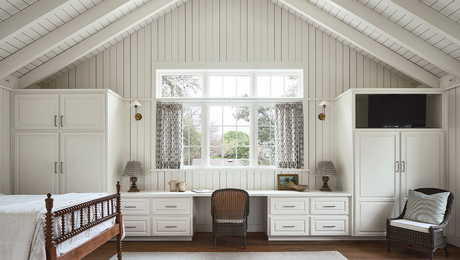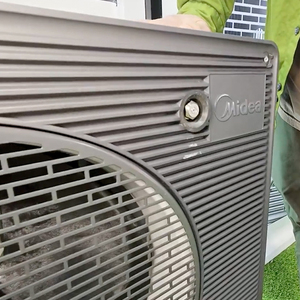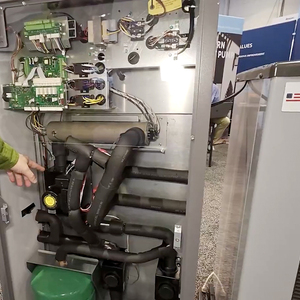*
We just purchased a 100 year old 3 family home that we plan to fully renovate (as much of the work by ourselves as we can). We’ve been looking into wiring each floor with telephone, television, and internet – broadband system I believe. But I haven’t had any luck in finding the best way to wire for the future, for example …
Is it a good idea to wire the internet through the kitchen for future appliance hook ups?
Are there any code restrictions as to how much we can do ourselves?
If broadband gets pulled into the house, how do I separate the 3 different apartments?
Any information you may have will be very helpful. Thank-you.



















Replies
*
Deanna, there's a useful article on this in the May, 2000 issue of JLC (Journal of Light Construction). Perhaps a contractor friend can share it with you.
Also, try a search here in the archives under "Cat 5", "Category 5", or "Cat-5".
You're on the right track to install this stuff now, and you may be able to do a lot of the work yourself.
Good luck, Steve
*I wish more people though ahead. It's just my guess but I suspect that the state of the art now will be the old and outdated soon. Instead of wiring for everything and hoping that what you install will be the right stuff for the next generation of appliances, I'd install conduit and keep a sketch of where it all goes so pulling the latest technology later would be easy.
*Both excellent suggestions. With Ryan's, ENT or "smurf" would be excellent conduit for this - if permitted in your jurisdiction. I read a little for wiring or office and JLC mentions that there is now or nearly a Category 5 enhanced which is a 10 or 100 fold increase over 100baseT - probably fast enough for quite a while in homes.
*Is that Cat 5-E?
*I don't know but believe that's what JLC called it.
*
Deanna: I recently wired my on house for lights, sound, and data. Everywhere I've ever lived, a homeowner is allowed to work on their own house, but if there is a building code/building permit system in place in your town or county you need to pull a permit and get the work inspected to be official about it. (Although unlike adding a new room, the sity is unlikely to notice the work. But the power company might insist on an inspection tag if they are going to have to disconnect/reconnect the service).
I went with more 120-volt circuits than code requires, used 12 gauge on all the 120-volt circuits even if 14-gauge was allowed. For high use area (kitchen, shop) I went with spec-grade, nylon-bodied receptacles ($4-8 instead of $1.50). DO NOT get the $0.39 receptacles with the push-in terminals - they are a fire hazard to rely on the pressure of a spring clip to carry the current and the plastic bodies shatter easily. Label your Romex with a laundry marker when you bring it into the breaker panel and leave an extra foot of length to play with. Can't have too many outlets in the kitchen.
Run a 30-amp circuit to the shop/garage for an air compressor, etc.
There are now wire strippers that strip the Romex sheath and the inner insulation in one step. Leaves a very clean end.
Home Depot had a "Homepack" or some such that was a square D service panel with a dozen breakers for less than the price of many unpopulated panels. Worked fine. Don't buy a small panel, 40 breakers is adaquate, 20 is not.
You area probably requires battery and line-voltage dual-powered smoke detectors in every bedroom. Run 14-3 Romex (3 conductor plus ground) to the first one and between them - they need to talk to each other through the third conductor.
I like Ryan's idea of conduit, but I'd only bother with it from your utility/junction box room and the home office and entertainment center. For the other areas, I'd brought Cat-5 and co-ax back to a junction box so connection and interconnections to rooms can be redone easily in the future. Running from box to box would have used less wire (about $40) but would have made for more connections, less bandwidth and less future flexibility. Some Cat-5 is better labeled (feet of length and wire pairs) than others, some are easier to strip and connect, prices vary a lot ($0.09/foot at Home Depot, Anchorage, $0.40 at Radio Shack). Take wire strippers and play with a foot before you buy the 250-500 feet you'll need.
"Is it a good idea to wire the internet through the kitchen for future appliance hook ups?"
So you can turn on the toaster from Chicago? Just run Cat-5 to each end of the kitchen and you'll be able to have up to 4 phones, or 4 computers, or any combination in the future.
Happy wiring, David
*
Deanna:
The wiring you are referring to is all considered low voltage wiring and therefore is not governed/inspected by building officials (or at least in my area, under CABO code). You can DYI to your heart's content!
*I am going through this on a house I am consulting on right now. My whole house data wiring guy has been into this stuff since the 70's. He is strangely knowledgable in this stuff.He says pull RG6 plus for data, cable and future. He pulls cat-5 enhanced or plus (ame thing - 100 Mbit/second) for phone or intercom. He also preferrs to run an extra RG6 plus for future closed circuit video or spare computer.We ran RG6 plus and cat-5 enhanced to nearly all rooms. Audio to 9 out of 16 rooms and three outside areas.I tell people this is the way to wire for the 90's. Yes I said 90's. If you don't do this you are wiring for the 70's, excpet you can use wall plates and receptacles from the 80's if you'd like.My guy says pulling a spare RG6 or two now is cheaper than conduit. he does not believe in the viability of fiber for home use.He is currently doing an 18,000 (no typo) sf house with this stuff everywhere you look!!!-Rob
*
Deanna,
try a search under "home automation".
The current standard for datacomm wiring is now two runs of RG-6 (double shield) coax to each location, and two runs of four pair, cat 5 UTP to each location. Be mindful that you have to run the UTP right or you lose performance. I know that the cable mfgrs are up to cat 7 already; my feeling is that for a residence, use a good cat 5 cable, install it right, and don't worry. Unless you're going to be doing CAD work or something, then run smurf tube to every location and be ready for fiber-to-the-desk. By location, I mean a place where you intend to use a computer or put a TV.
One place I would run pipe (conduit) of some sort is from the telephone network interface device (SNI, NID, POP, or whatever it's called in your neighborhood) to your telephone closet.
Have fun! Are you going to replace the old plaster with blue board and veneer plaster?
Good luck.
*
EMT conduit from a wall box to the atic or basement is not difficult to install. This is what I did in my new house and it works great. I recomend 3/4" emt , as it will hold three RG-6 or other combinations that I have already needed in the few months I have lived here. Also, I installed two 2" PVC conduits from the attic to the basement for future wire pulls. Just cap them off for now to eliminate draft, fire draft, etc.
Home runs of Cat-5 from each room to a central location is also a good suggestion for phone, etc.
Frank
*Good advice. I agree that you should assume whatever you put in will be outmoded before long, so don't waste money running stuff you don't even have a hazy idea of using. Hey, you might move, too.Note re Cat-5 cable, the more-or-less standard in offices and homes: there are now gigabit networking adapters (yep, 1000base-T) for use over Cat-5, despite the supposed limitation of the wire to 200 or so -- see, e.g., <a href=http://www.asante.com/index.html>Asanté (it uses two extra pairs of wire to beat 100base-T, 10 times the speed for twice the # of wires). I strongly believe that when this sort of home tech stuff becomes common manufacturers will pull rabbits out of hats to run data over "dated-tech" existing systems already in office buildings and homes -- I'm amazed how much data they can cram through plain old copper wires, look at DSL. Or, like Apple's Airport, they'll go wireless. in other words, the mfrs will be eager to please, don't assume the current paradigm predicts the future.So, don't spend a fortune, just a couple runs of cat-5, some RJ6 coax, you're fine. Maybe security, intercom, DSS, etc. for specific needs. Focus mostly on staying AWAY from electrical wiring and other sources of interferance. I like a star topology, that is, a central box with switches and patch cables, wires radiating to various parts of the house. From personal experience, consider patch panels to make the connections; it will ease expansion and troubleshooting. One of our phone jacks got a few drops of water on it and fritzed out the whole house with static....The only problem I have with home automation is that it all seems so silly. A toaster on the internet? A refrigerator that calls for help before it breaks -- why not make one that DOESN'T break? But I am getting a lot of use over the Ethernet I've put in so far for the computers, and I assume before long they'll deliver on-demand video content over twisted pair, giving cable a kick in the rear.
*Just curious about how these plans might need to be altered to be "wired" for wireless.
*And be careful about sizing the conduit if you run some. I ran 3/4" in some concrete. My installer said it was useless for the combo [2-RG6 and 2-Cat5] lines that he likes to install today. That stuff is shielded and really thick. Does not bend easily or slide through conduit easily. In our case, should have used 2" for easier wire pulling.
*I hate to do this, adding more opinion the the world, but as a professional computer geek, I can't keep my mouth shut on the subject. The fact is that NOBODY knows what the future of home automation, TV feeds, telephone and computer communication will be. There is some supposed convergence of all these, but it is theoretical at best. If you want to have an in-house network, don't spend a bundle to be 'ready for the future.' Your (and mine and anyone else's) guess of the infrastucture of household communication wiring is really a shot in the dark. Worry about what will work today.That said, there are several general themes that will probably continue for a while.1) TV will probably be on coax. Put in as many outlets as you like. Use good copper shielded cable. The stuff the cable companies use is crap.2) Telephones will probably continue to use plain old copper.3)Networks will probably still use unsheilded twisted pair cable for awhile. Good stuff can handle some serious bandwith. Buying the better stuff (cat 5+) is a good bet. Don't go crazy putting in outlets and runs that may not see use for 10-20 years. By then fiber or wireless or something may be the standard. Not to say that lots of wire is a always a bad thing. Often times it can end up being money poured down a hole. I saw one house where every electrical thing in the house was tied into the network and controllable by the phone or internet anywhere in the world. BUT, I'm guessing that they spent several hundred K so they can turn on the blender from Malta. And they'll NEVER do it. You should see the wiring closet. It's bigger than my kitchen.I take the philosophy that you put in what is really useful now. Put in those TV outlets and lots of phone jacks. Put in Cat 5 and jacks where you might use a computer or computerized device. By the bed for working on a laptop is a great idea. In the kitchen for the internet ready refrigerator is not (this idiotic thing really exists). Run the cables to expandable hubs in the basement or a closet somewhere. Leave room in the walls to upgrade and update if the need should arise.This is just one networking guy's notion of what is useful. Most of the over the top cabling & networking schemes that one sees in the McMansions is only there for 2 reasons. It is a great buzz word to help close a sales deal. It impresses the friends of the owners though it will see little if any use.If you want more info on the nuts and bolts of cabling get Black Box's catalog, orderable from their website.Mike
*Mike's right on....And remember, wireless means no wires needed!!!My cordless phone works in all rooms in every corner and even all the way down to the nearest pub!Did I say near the pub, by the stream,aj
*All good advice Deanna. But I have to add: Think about where you are building when you add in all this high tech stuff. When I wired the house I am building I used rg-6 for the sattelite dish( no cable T.V. out here in the piney piney woods). Used cat-5 for phone(why not?) Phone guy comes out from the big city to hook me up to pac-bell and laughs at my cat 5. Tells me "You're out here in the sticks. All you have running to your house is cat 3 anyway." So I thanked him for the honest appraisal, gave him a cool beverage and now I have more cat-5 running through my home than I will ever use.My point is that all this high tech wiring is great, and is a pretty small initial cost, but it's easy to get caught up and wire for a bunch of stuff you will never use. Just my two cents.
*Believe it or not, the first generation of 'internet-ready' appliances are about to debut. Anticipating such things as on-line problem-solving, controls, etc. Hard to imagine.On the threads theme I always run 1" empty conduit (Carlon is fine)with pull string from basement to attic, and perhaps down to a significant work area like a study if on the second floor, just in case. I agree that the future is tough to predict. Rumors of Princeton being a fiber optic test site - not sure if true. PS to wire geeks - isn't there a combination cat5 / fiber optic cable around for just a little more than cat5? I heard about it ...
*Believe it or not, local inspectors here are requiring boxes and inspection for low voltage, cable, etc. Fees, fees, fees.
*Don't feel bad, the price increment is nothing and resistance to common internal interference -- that's where teh signal gets the mot abuse -- is very important.
*Jeff, aren't you in NJ? State law requires permits, inspection, etc for anything over 10V. Exemptions are lawn sprinklers under 30V and home alarms under 30V. Communication wiring is less than 10V. As a side note, I always wondered how telephone wiring fit in. 90VAC during a ring, 50VDC when the line is silent. Not that I think they should require permits. I don't even think they should be required to build a nuclear missle but what do I know.
*What do you expect from the only state that won't let you pump your own gas? Pretty soon they'll change their slogan to "The Idiot-Proof State ... Plus the Dump Part of Ellis Island."
*
All this advise and brain storming has been wonderful! Thank-you all for your two cents. I'm now very exited about researching this information more and finding out what will work best for us.
Thank-you again.
*
We just purchased a 100 year old 3 family home that we plan to fully renovate (as much of the work by ourselves as we can). We've been looking into wiring each floor with telephone, television, and internet - broadband system I believe. But I haven't had any luck in finding the best way to wire for the future, for example ...
Is it a good idea to wire the internet through the kitchen for future appliance hook ups?
Are there any code restrictions as to how much we can do ourselves?
If broadband gets pulled into the house, how do I separate the 3 different apartments?
Any information you may have will be very helpful. Thank-you.
*
It later occured to me: I've been looking at switches and routers
for connecting a group of computers to broadband service --
that's the phone company's problem to upgrade if they want to
compete with cable & satellite! -- anyway, cat 3 supports the 10
Mbps that is the broadband limit for now (DSL), but INSIDE the
house, if you isolate the house network with a router, the traffic
could easily be 100 Mbps or 1000.... with the right cables.
The router/switch i found for $150 does just that -- connects up to
four devices at 10/100 Mbps ethernet, and a 10 Mbps DSL or
cable connection on the other. The separation of the two also
allows the creation of a "firewall" to keep hackers out.